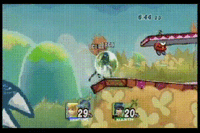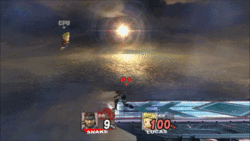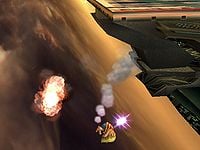Stage spike: Difference between revisions
(article is fine; if not bring it up on talk) |
m (Text replacement - "|thumb|right" to "|thumb") |
||
| (49 intermediate revisions by 32 users not shown) | |||
| Line 1: | Line 1: | ||
A '''stage spike''' is a | {{ArticleIcons|series=yes|unofficial=yes}} | ||
[[File:Stage Spike Brawl.gif|thumb|250px|{{SSBB|Snake}} using his [[back aerial]] to stage spike {{SSBB|Lucas}} in ''Brawl''.]] | |||
[[File:SSBB Marth Footstool Spike to Stage Spike.gif|thumb|{{SSBB|Marth}} [[punish]]ing {{SSBB|Zero Suit Samus}}'s [[meteor cancel]] after a footstool spike by using [[Dolphin Slash]] to stage spike her.]] | |||
A '''stage spike''' (officially known as an '''edge meteor''') is what occurs when a [[fighter]] is knocked against part of the [[stage]], which causes them to bounce downward in a similar fashion to a [[meteor smash]]. Stage spikes can be used as an [[edge-guarding]] or as a [[edge-guard break]]ing technique, depending on who is doing the stage spike. One example is [[Marth]] using his [[Dolphin Slash]] below the stage to knock a recovering opponent into the stage, [[Knockout|knocking them out]]. Unlike meteors, stage spikes can easily occur by accident. | |||
==Applications== | ==Applications== | ||
Stage spikes are | Stage spikes are most useful for characters who have difficulty KOing opponents otherwise (such as {{SSBB|Sonic}}), though they are incredibly useful for any character as they provide the means for an early KO. Stage spikes usually occur when an opponent is recovering from below near the stage, where the edge-guarder can then drop off and hit the opponent with an aerial, knocking them into the stage and stage spiking as a result. Stage spikes also commonly occur to reckless edge-guarders, who get hit into the stage and stage spiked from the opponent's recovery move; this especially happens when a player attempts to [[edgehog]] too soon and runs out of their ledge invincibility before the opponent's recovery move hits them. The risk of getting stage spiked can serve as a significant deterrent to edge-guarding characters whose recovery moves deal high knockback, such as the aforementioned Marth and {{SSBB|Meta Knight}}. | ||
There are no flaws with stage spiking in the original ''Super Smash Bros.'', but the addition of [[tech]]ing on walls and ceilings in ''[[Super Smash Bros. Melee]]'' allows stage-spiked characters to completely nullify the knockback; as teching can be buffered in ''Melee'' by pressing the button before even taking the hit, this can be done with relative ease if the victim predicts it. ''[[Super Smash Bros. Brawl]]'' disables the ability to buffer techs in this way, which makes the timing more strict and makes stage spikes overall more effective. This ability was restored in ''[[Super Smash Bros. Ultimate]]'', while also revamping the tech mechanics to make untechable situations knockback-based rather than strictly situational. Additionally, if a character is stage spiked with their total launch speed being 3 units per frame or higher (3 units being half the launch speed of when teching is impossible), when they reach about 25 units below the camera boundary they will be KO'd before reaching the lower blast line, much like [[meteor smash]]es. | |||
Self stage spiking | ==Self-stage spiking== | ||
[[File:StageSpike.jpg|thumb|Lucas' PK Thunder self-stage spike.]] | |||
Self-stage spiking involves a failed [[recovery]] move. Self-stage spiking occurs when the player tries to recover, but instead, in addition to missing the ledge, ends up hitting part of the stage, bouncing off, and then falling down as if they were [[spike]]d. [[Ness]] and [[Lucas]], as part of their [[PK Thunder]] attacks, are particularly prone to self-stage spiking. [[Fox]], [[Falco]], [[Diddy Kong]], and [[Lucario]] are also prone to self-stage spiking, albeit to a lesser extent, due to them having more control over which direction their recoveries travel in. | |||
== | ==Examples== | ||
*[http://www.youtube.com/watch?v=Q4ccWL8EUvM Marth stage spiking with Dolphin Slash] | |||
*[http://www.youtube.com/watch?v=TJHtfk8gK1U Ness stage spiking with his down smash] | |||
*[http://www.youtube.com/watch?v=eWG8Usl-hLE Sonic stage spiking with his back aerial] | |||
==See also== | |||
*[[Meteor smash]] - an attack that deals downward knockback but can be recovered from through [[meteor canceling]] in ''Melee'' and ''Brawl''. | |||
* | *[[Semi-spike]] - an attack that hits the opponent at a low horizontal angle that hinders recovery opportunities. | ||
* | |||
{{AllGames|Techniques}} | |||
[[Category: | [[Category:Game mechanics]] | ||
Latest revision as of 09:02, April 12, 2023

A stage spike (officially known as an edge meteor) is what occurs when a fighter is knocked against part of the stage, which causes them to bounce downward in a similar fashion to a meteor smash. Stage spikes can be used as an edge-guarding or as a edge-guard breaking technique, depending on who is doing the stage spike. One example is Marth using his Dolphin Slash below the stage to knock a recovering opponent into the stage, knocking them out. Unlike meteors, stage spikes can easily occur by accident.
Applications[edit]
Stage spikes are most useful for characters who have difficulty KOing opponents otherwise (such as Sonic), though they are incredibly useful for any character as they provide the means for an early KO. Stage spikes usually occur when an opponent is recovering from below near the stage, where the edge-guarder can then drop off and hit the opponent with an aerial, knocking them into the stage and stage spiking as a result. Stage spikes also commonly occur to reckless edge-guarders, who get hit into the stage and stage spiked from the opponent's recovery move; this especially happens when a player attempts to edgehog too soon and runs out of their ledge invincibility before the opponent's recovery move hits them. The risk of getting stage spiked can serve as a significant deterrent to edge-guarding characters whose recovery moves deal high knockback, such as the aforementioned Marth and Meta Knight.
There are no flaws with stage spiking in the original Super Smash Bros., but the addition of teching on walls and ceilings in Super Smash Bros. Melee allows stage-spiked characters to completely nullify the knockback; as teching can be buffered in Melee by pressing the button before even taking the hit, this can be done with relative ease if the victim predicts it. Super Smash Bros. Brawl disables the ability to buffer techs in this way, which makes the timing more strict and makes stage spikes overall more effective. This ability was restored in Super Smash Bros. Ultimate, while also revamping the tech mechanics to make untechable situations knockback-based rather than strictly situational. Additionally, if a character is stage spiked with their total launch speed being 3 units per frame or higher (3 units being half the launch speed of when teching is impossible), when they reach about 25 units below the camera boundary they will be KO'd before reaching the lower blast line, much like meteor smashes.
Self-stage spiking[edit]
Self-stage spiking involves a failed recovery move. Self-stage spiking occurs when the player tries to recover, but instead, in addition to missing the ledge, ends up hitting part of the stage, bouncing off, and then falling down as if they were spiked. Ness and Lucas, as part of their PK Thunder attacks, are particularly prone to self-stage spiking. Fox, Falco, Diddy Kong, and Lucario are also prone to self-stage spiking, albeit to a lesser extent, due to them having more control over which direction their recoveries travel in.
Examples[edit]
- Marth stage spiking with Dolphin Slash
- Ness stage spiking with his down smash
- Sonic stage spiking with his back aerial
See also[edit]
- Meteor smash - an attack that deals downward knockback but can be recovered from through meteor canceling in Melee and Brawl.
- Semi-spike - an attack that hits the opponent at a low horizontal angle that hinders recovery opportunities.

